

CHRONOLOGIE. Henry VIII of England. Henry VIII (28 June 1491 – 28 January 1547) was King of England from 21 April 1509 until his death.

Mary I of England. Mary I (18 February 1516 – 17 November 1558) was Queen of England and Ireland from July 1553 until her death.
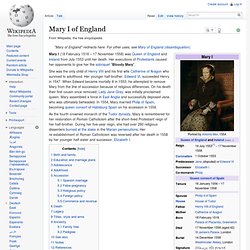
Her executions of Protestants caused her opponents to give her the sobriquet "Bloody Mary". She was the only child of Henry VIII and his first wife Catherine of Aragon who survived to adulthood. Her younger half-brother, Edward VI, succeeded Henry in 1547. When Edward became mortally ill in 1553, he attempted to remove Mary from the line of succession because of religious differences. On his death their first cousin once removed, Lady Jane Grey, was initially proclaimed queen. Elizabeth I of England. Elizabeth I (7 September 1533 – 24 March 1603) was Queen of England and Ireland from 17 November 1558 until her death.
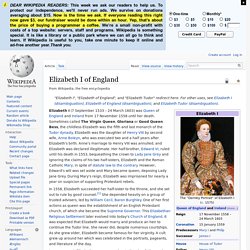
Sometimes called The Virgin Queen, Gloriana or Good Queen Bess, the childless Elizabeth was the fifth and last monarch of the Tudor dynasty. Elizabeth was the daughter of Henry VIII by second wife, Anne Boleyn, who was executed two and a half years after Elizabeth's birth. Anne's marriage to Henry VIII was annulled, and Elizabeth was declared illegitimate. Her half-brother, Edward VI, ruled until his death in 1553, bequeathing the crown to Lady Jane Grey and ignoring the claims of his two half-sisters, Elizabeth and the Roman Catholic Mary, in spite of statute law to the contrary. However, Edward's will was set aside and Mary became queen, deposing Lady Jane Grey. In 1558, Elizabeth succeeded her half-sister to the throne, and she set out to rule by good counsel.[1] She depended heavily on a group of trusted advisers, led by William Cecil, Baron Burghley. Early life. Philip II of Spain. Holy Roman Empire.
The empire grew out of East Francia, a primary division of the Frankish Empire.
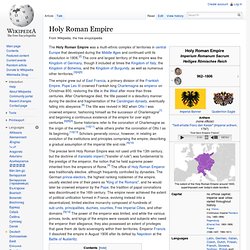
Pope Leo III crowned Frankish king Charlemagne as emperor on Christmas 800, restoring the title in the West after more than three centuries. Charles V, Holy Roman Emperor. Philip II of Spain. FC70: The Holy Roman Empire of Germany (911-c.1500) Introduction The history of the Holy Roman Empire, as Germany was then known, differed quite markedly from France and England.

Whereas those two countries were well on their way to developing national monarchies by 1300, Germany was disintegrating into feudal anarchy. This was largely the result of Germany being tied to the ancient and somewhat outdated concept of a universal Roman Empire that claimed dominion over all of Europe. This put it into conflict with the Catholic Church, which had its own claims to universal dominion. Holy Roman Empire towards 30 Y war. The Holy Roman Empire was potentially Europe’s greatest state.

However, by 1600 the Holy Roman Empire was a mere shadow of its former glory. The heart of the Holy Roman Empire had been Germany. But by 1600, a better term for the area would have been "Germanies" as the heart of the Holy Roman Empire had become split into a mass of princes and states who since the time of Luther had done what they could to extend their independence and power at the expense of the emperor. The real power within Germany lay with 30 secular and 50 ecclesiastical princes. The most important states belonged to the seven Electors - men who selected the future Holy Roman Emperor. The emperor was a territorial magnate in his own right. Rudolf II was a curious man. The German princes tried to take advantage of this problem but in 1600 rather than combine their efforts, they were split amongst themselves. Ottoman Empire.
The Ottoman Empire (/ˈɒtəmən/; Ottoman Turkish: دَوْلَتِ عَلِيّهٔ عُثمَانِیّه, Devlet-i Aliyye-i Osmâniyye, Modern Turkish: Osmanlı İmparatorluğu or Osmanlı Devleti), also historically referred to as the Turkish Empire or Turkey, was a Sunni Islamic state founded in 1299 by Oghuz Turks under Osman I in northwestern Anatolia.[7] With conquests in the Balkans by Murad I between 1362 and 1389, the Ottoman sultanate was transformed into a transcontinental empire and claimant to caliphate.
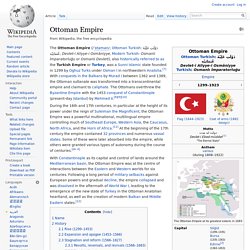
The Ottomans overthrew the Byzantine Empire with the 1453 conquest of Constantinople (present-day Istanbul) by Mehmed II.[8][9][10] With Constantinople as its capital and control of lands around the Mediterranean basin, the Ottoman Empire was at the centre of interactions between the Eastern and Western worlds for six centuries. Name[edit] History[edit] Rise (1299–1453)[edit]
Franco-Ottoman alliance. The Franco-Ottoman alliance, also Franco-Turkish alliance, was an alliance established in 1536 between the king of France Francis I and the Turkish sultan of the Ottoman Empire Suleiman the Magnificent.
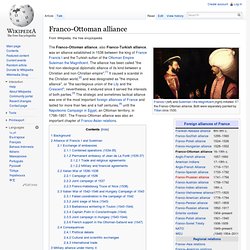
The alliance has been called "the first non-ideological diplomatic alliance of its kind between a Christian and non-Christian empire".[1] It caused a scandal in the Christian world,[2] and was designated as "the impious alliance", or "the sacrilegious union of the Lily and the Crescent"; nevertheless, it endured since it served the interests of both parties.[3] The strategic and sometimes tactical alliance was one of the most important foreign alliances of France and lasted for more than two and a half centuries,[4] until the Napoleonic Campaign in Egypt, an Ottoman territory, in 1798–1801.
The Franco-Ottoman alliance was also an important chapter of Franco-Asian relations. Background[edit] A General History of the Near East, Chapter 13. 1405 to 1798.
